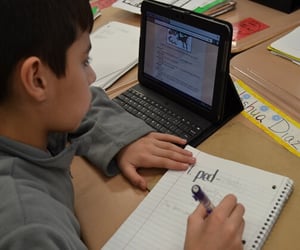
Despite facing challenges that are common in large, urban school districts today, Chicago Public Schools has been on the leading edge of innovation regarding the use of mobile devices in their classrooms.
Starting with the 2010-2011 school year, Chicago’s mobile learning initiative has been the largest centralized deployment of tablet computers to students and teachers in the United States. However, those tablets were not allowed to go home with the students; they were for in-school use only. While the impact in the classroom was significant, the district was missing the opportunity to extend learning beyond the school day and to leverage these devices for increased Internet access. Like many districts, Chicago was concerned about student Internet use and online safety once they left school.
NEW APPROACH TO BRIDGING THE DIGITAL DIVIDE
As could be expected, the students were very interested in having the ability to take tablets with them to use for homework, research and communications with peers and teachers. In consultation with the Chicago Ed Tech Department, Kajeet designed a landmark pilot project that provided safe broadband for students to use their tablets both at school and beyond. Qualcomm’s Wireless Reach Initiative provided funding for this innovative project.
Starting in fall 2012, fifth grade students from one neighborhood school on Chicago’s west side were each assigned HTC EVO Tablets with management through the Kajeet Sentinel® platform in the cloud.
For the first time in Chicago, these136 students could take those tablets home with them to extend their learning day beyond 3 p.m. For 61 percent of those students and their families, they now had high-speed Internet access for the first time outside school. Most importantly, the Chicago administrators were able to use the Kajeet Sentinel platform’s time-based filtering to shut off the Internet access on all the devices at 9 p.m. and to document what websites students were accessing through their tablets anytime.
“I think the benefit of having my own tablet to help me with my schoolwork is that at my house I don’t have Internet and the tablet comes with Internet. I can use the Internet at home so I can research important schoolwork.”
5th Grade Student, Kajeet – Chicago Public Schools Project
WHY KAJEET?
While many districts and schools continue to struggle with how to effectively implement mobile devices for learning, Kajeet has proven solutions that address the balancing act of student safety with improved learning outcomes. The Kajeet Sentinel platform gives administrators and teachers peace of mind about student safety online and the tools needed to manage student access to the plethora of rich digital content and websites for learning. The time-based filtering allows differentiated policies at school, home or bedtime for Internet access.
With the fifth graders in Chicago, it was very important to the teachers that their students were getting enough sleep – turning off the devices at 9 p.m. gave them the assurances that at least the tablets and broadband access were not the culprits for sleepy 11-year olds in class the next day.
The innovative technology from Kajeet provides district technology leadership with visibility into the online sites that students are visiting, no matter where they are. The analysis of traffic data from the Chicago pilot site indicated that three-quarters of the online usage was taking place between 3 p.m. and 9 p.m. on school days. While the students did visit websites for entertainment and their favorite sports teams, they also spent a lot of time each day on education sites for math, science and reading to support their homework activities.
For example, a class discussion on Alaska that was part of their reading lesson created a flurry of online searches by the students about Alaskan wildlife, demographic and economic data after school hours. Not only did this reassure the district leadership that using the tablets to extend learning beyond the school day was a good idea, it also encouraged the teachers to creatively assign more Internet-based reading and homework activities.
BOTH STUDENTS AND TEACHERS WIN!
Access to the Internet really matters for today’s students. While the tablets enabled the students to have ubiquitous access to the Internet at school, the key benefit of the tablets is that students could check their grades, email their teachers with questions and still not need to compete with peers or family members to access to online textbooks from home.
The education process for these young students in Chicago has increasingly become a seamless series of learning events, both self-directed and teacher-directed, that can happen anywhere. Mobile devices in concert with Kajeet technology are helping students achieve one of the most significant aspirations of the National Education Technology Plan – to create lifelong, life wide and life deep learners.
Teachers win with mobile learning, too. As evidenced by the evaluation study on the Chicago pilot, teachers are enjoying increased personal and professional productivity as a result of the tablets, and feel a stronger connection to their students. The tablets provide a way for students to become more engaged in school and to take increased responsibility for their own learning and digital citizenship with the out-of-school access.

